

Maya moon goddess. The Moon Goddess in the Classic period The traditional Mayas generally assume the moon to be female, and the moon's phases are accordingly conceived as the stages of a woman's life.
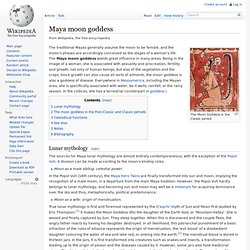
The Maya moon goddess wields great influence in many areas. Being in the image of a woman, she is associated with sexuality and procreation, fertility and growth, not only of human beings, but also of the vegetation and the crops. Since growth can also cause all sorts of ailments, the moon goddess is also a goddess of disease. Everywhere in Mesoamerica, including the Mayan area, she is specifically associated with water, be it wells, rainfall, or the rainy season. Lunar mythology[edit] The sources for Maya lunar mythology are almost entirely contemporaneous, with the exception of the Popol Vuh. Moon as a male sibling: celestial power. Moon as a wife: origin of menstruation.
Ixchel. Ixchel or Ix Chel (Mayan: [iʃˈt͡ʃel]) is the 16th-century name of the aged jaguar goddess of midwifery and medicine in ancient Maya culture.
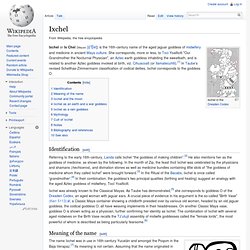
She corresponds, more or less, to Toci Yoalticitl "Our Grandmother the Nocturnal Physician", an Aztec earth goddess inhabiting the sweatbath, and is related to another Aztec goddess invoked at birth, viz. Cihuacoatl (or Ilamatecuhtli).[1] In Taube's revised Schellhas-Zimmermann classification of codical deities, Ixchel corresponds to the goddess O.
Identification[edit] Referring to the early 16th-century, Landa calls Ixchel “the goddess of making children”.[2] He also mentions her as the goddess of medicine, as shown by the following. Ixchel was already known to the Classical Mayas. Maya Hero Twins. The Hero Twins shooting a perched bird demon with a blowgun.
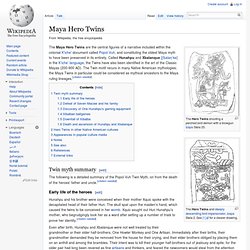
Izapa Stela 25. The Maya Hero Twins are the central figures of a narrative included within the colonial K'iche' document called Popol Vuh, and constituting the oldest Maya myth to have been preserved in its entirety. Called Hunahpu and Xbalanque [ʃɓalaŋˈke] in the K’iche’ language, the Twins have also been identified in the art of the Classic Mayas (200-900 AD).
The Twin motif recurs in many Native American mythologies; the Maya Twins in particular could be considered as mythical ancestors to the Maya ruling lineages. [citation needed] Twin myth summary[edit] Awilix. The Classic period Maya moon goddess may have been a forerunner of Awilix Awilix (/äwiˈliʃ/) (also spelt Auilix and Avilix) was a goddess (or possibly a god) of the Postclassic K'iche' Maya, who had a large kingdom in the highlands of Guatemala.[1] She was the patron deity of the Nija'ib' noble lineage at the K'iche' capital Q'umarkaj, with a large temple in the city.
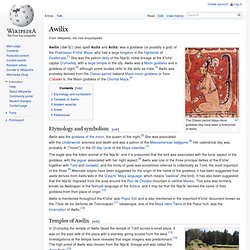
Awilix was a Moon goddess and a goddess of night,[2] although some studies refer to the deity as male.[3] Awilix was probably derived from the Classic period lowland Maya moon goddess or from C'abawil Ix, the Moon goddess of the Chontal Maya.[4] Etymology and symbolism[edit] Awilix was the goddess of the moon, the queen of the night.[5] She was associated with the Underworld, sickness and death and was a patron of the Mesoamerican ballgame.[6] Her calendrical day was probably ik' ("moon") in the 20-day cycle of the Maya calendar.[7]
Maya mythology. Maya mythology is part of Mesoamerican mythology and comprises all of the Maya tales in which personified forces of nature, deities, and the heroes interacting with these play the main roles.
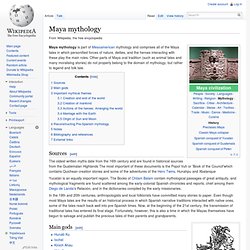
Other parts of Maya oral tradition (such as animal tales and many moralising stories) do not properly belong to the domain of mythology, but rather to legend and folk tale. Sources[edit] The oldest written myths date from the 16th century and are found in historical sources from the Guatemalan Highlands The most important of these documents is the Popol Vuh or 'Book of the Council'which contains Quichean creation stories and some of the adventures of the Hero Twins, Hunahpu and Xbalanque Yucatán is an equally important region. In the 19th and 20th centuries, anthropologists and local folklorists have committed many stories to paper. Main gods[edit] Important mythical themes[edit]